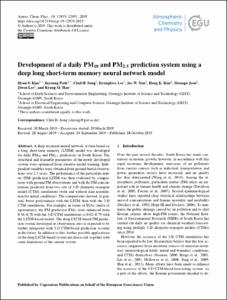GIST Scholar
College of Engineering
Department of Environment and Energy Engineering
1. Journal Articles
Development of a daily PM10 and PM2.5 prediction system using a deep long short-term memory neural network model
- Type
- Article
- Citation
- ATMOSPHERIC CHEMISTRY AND PHYSICS, v.19, no.20, pp.12935 - 12951
- Issued Date
- 2019-10
- Abstract
- A deep recurrent neural network system based on a long short-term memory (LSTM) model was developed for daily PM10 and PM2.5 predictions in South Korea. The structural and learnable parameters of the newly developed system were optimized from iterative model training. Independent variables were obtained from ground-based observations over 2.3 years. The performance of the particulate matter (PM) prediction LSTM was then evaluated by comparisons with ground PM observations and with the PM concentrations predicted from two sets of 3-D chemistry-transport model (CTM) simulations (with and without data assimilation for initial conditions). The comparisons showed, in general, better performance with the LSTM than with the 3-D CTM simulations. For example, in terms of IOAs (index of agreements), the PM prediction IOAs were enhanced from 0.36-0.78 with the 3-D CTM simulations to 0.62-0.79 with the LSTM-based model. The deep LSTM-based PM prediction system developed at observation sites is expected to be further integrated with 3-D CTM-based prediction systems in the future. In addition to this, further possible applications of the deep LSTM-based system are discussed, together with some limitations of the current system.
- Publisher
- COPERNICUS GESELLSCHAFT MBH
- ISSN
- 1680-7316
- 파일 목록
-
-
Download
 Development_of_a_daily_PM10_and_PM25_prediction_system_using_a_deep_long_shortterm_memory_neural_net.pdf
기타 데이터 / 10.96 MB / Adobe PDF
Development_of_a_daily_PM10_and_PM25_prediction_system_using_a_deep_long_shortterm_memory_neural_net.pdf
기타 데이터 / 10.96 MB / Adobe PDF
-
Items in Repository are protected by copyright, with all rights reserved, unless otherwise indicated.